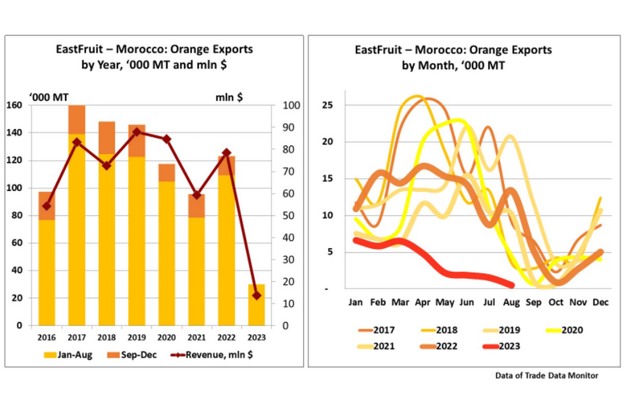Despite being one of the world’s largest producers of oranges, Morocco has significantly reduced its exports of this product. According to EastFruit, only 30 thousand tons of oranges worth 13.7 million dollars were imported from Morocco to foreign countries in 8 months of 2023. For comparison, in the same period last year, local growers managed to deliver 109 thousand tons of these citrus fruits to foreign markets, receiving the export revenue of 71 million dollars.
“Morocco is the third largest country in Africa in terms of orange production after Egypt and South Africa. However, unlike its continental neighbors, Morocco will greatly reduce its exports of these citrus fruits for several reasons by the end of the current season. According to our calculations, the export of Moroccan oranges for the 2022/23 season will collapse to the lowest level in at least the last 8 years,” warns Yevhen Kuzin, Fruit & Vegetable Market Analyst at EastFruit.
The peak of Moroccan orange deliveries abroad was recorded in 2017, when the country imported more than 160 thousand tons of this product to foreign markets. Since then, sales volumes have decreased almost annually, reaching a minimum in the current year, and Morocco has moved from 11th position (2022) to 13th place (according to data for January-August 2023) in the list of world exporters.
The main factor affecting the rapid decline in orange exports is unfavorable weather conditions. Climate change and water scarcity affect the increase in frequency and intensity of drought periods in Morocco, and the temperature rises to critically high levels.
For example, in August of this year, an absolute temperature record was recorded in the country (while local growers hoped that high temperatures would not cause damage to citrus fruits). Nevertheless, abnormal heat affected yields, and, accordingly, production decreased and harvesting areas were reduced.
It should be noted that the decline was observed not only in Morocco, global production of these citrus fruits also demonstrated a downward trend. Drought in Spain and Italy, hurricanes in the USA, frosts in Turkey – natural anomalies that key suppliers of oranges faced, negatively affected orange production.
For more information: east-fruit.com

